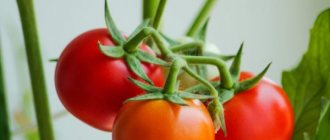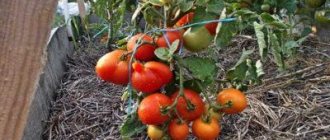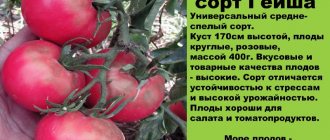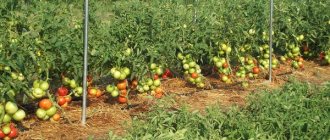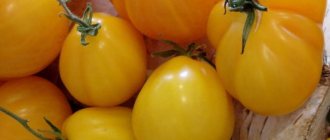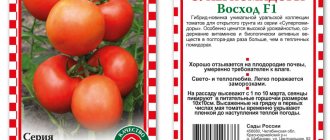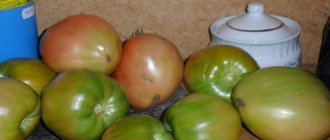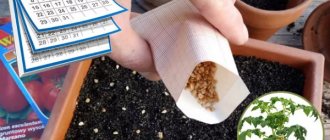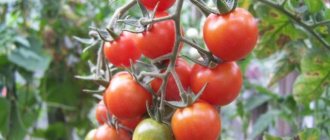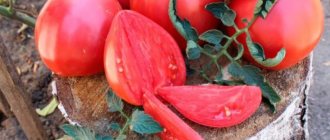The tomato, which is better known as “Pink Cream,” is well known to vegetable growers in Russia. This is one of the most successful varieties, which does not require special growing conditions and at the same time invariably produces good yields.
| Height | Landing location | Ripening time | Fruit color | Fruit size | Origin | Fruit shape |
| Medium height | Greenhouse, Open ground | Mid-early | Pink | Small | Variety | Plum-shaped or oval |
Description of the tomato variety “Large Cream”
Table variety, mid-season. The period of full ripening is 105-110 days from the moment of emergence. The determinate bush is compact.
The plant does not grow higher than 60 cm. The foliage is average.
Fruit
As the name suggests, the fruits of this variety have an oblong, plum-shaped shape, with a characteristic spout. The average weight of one tomato is 70-90 grams. Skin color is light red.
Other fruit characteristics:
- Elastic peel that perfectly protects against mechanical damage;
- Dense and juicy pulp with minimal wateriness;
- A small number of seeds;
- Moderately sweet taste.
Moscow region beds
In each region of Russia, summer residents have their own favorite varieties of tomatoes. If you consider the characteristics and description of the tomato variety Slivovka and others in the table below, you can understand why they are so attractive to gardeners in the Moscow region.
Tomatoes popular in the Moscow region
| Variety | Peculiarities |
| Slivovka | · An extra-early variety that produces a nice cream with a “spout.” The red fruits are smooth, slightly flattened at the stalk. They have low-juicy, fleshy pulp and a sour taste; |
| · Gardeners are attracted by its unpretentiousness, good immunity, the formation of ovaries, regardless of weather conditions, and the friendly yield of the harvest; | |
| · The fruits are marketable and transportable. If you pick them up from the bush when they are brown, they will rest quietly in the cellar until the beginning of winter. Good at preserving | |
| Cream Honey Tomato | · The hybrid variety is represented by determinate standard bushes. Despite their early maturity, they are grown not only in open ground, but also in greenhouses; |
| · The smooth red fruit with fleshy pulp has high tasting qualities and a pleasant aroma. A special feature of the Honey Cream tomato is the small number of chambers with seeds; | |
| · With tomatoes weighing up to 70 g, you can get about 4.5 kg from one square meter; | |
| · The variety is characterized by the following qualities: cream marketability, disease resistance, stable yield | |
| Moscow | · This is not just a variety - under this name there are several varieties of the crop, differing in color shades. The most popular among farmers are chocolate and yellow; |
| · Slivka Moskovskaya tomatoes have a sweetish taste with a slight piquant note, which allows the variety to be used more often than others for making ketchups and sauces; | |
| · The fruits are elastic, with low moisture content and a high percentage of glucose. At the time of ripening, tomatoes reach a weight of 130 g, which ensures good yield; | |
| · The variety is unpretentious to growing conditions, but has weak immunity to fungal diseases | |
| lady finger | · Determinate bush, up to 1 m high, bears fruit 3.5 months after planting. Graceful tomatoes are shaped like their name. Elongated tomatoes grow up to 8 cm in length and gain an average mature weight of 140 g; |
| · From one square meter, using conventional agricultural technology, a summer resident collects up to 6 kg of elastic fruits with a glossy skin. They are suitable for long-term transportation, retain marketability for a long time and have good taste. |
Read also: Do birch trees grow in the Crimea
Having studied all the characteristics of tomatoes, gardeners select those that they like most. When choosing varieties for open ground, the emphasis is on regionality, because for areas with a short growing season you should not choose late-ripening Cream.
Tomatoes: advantages and disadvantages
Advantages of "Large Cream":
- Undemanding to soil, climate and agricultural technology;
- Strong immunity to specialized diseases of nightshade crops;
- Excellent keeping quality;
- Transportability over any distance;
- Impeccable taste.
The disadvantages of this variety are inherent in most tomatoes.:
- Needs balanced watering;
- High yields are achieved only with proper feeding.
The most popular varieties
Slivka giant is a tall, indeterminate, mid-season tomato variety with large red elongated fruits. The pulp is sweet and dense. Transports well over long distances.
Orange cream is a high-yielding, mid-season semi-determinate variety. The height of the bushes is small, up to 1.2 m. The fruits are very decorative, orange, weighing 50-60g with an increased content of carotene. The variety is resistant to temperature changes.
Chio-chio-san is a mid-season indeterminate variety for film greenhouses. Forms a very large and branched cluster with more than 50 pink fruits.
Watercolor is an early-ripening standard low-growing variety. The fruits are red and sweet. Resistant to septoria and blossom end rot.
De Barao is one of the most famous late varieties. The bushes are very powerful, tall, indeterminate, and require constant pinching. The variety is very resistant to late blight. This variety has many colored varieties: red, pink, orange, yellow, black. The fruits themselves are smooth, oval, even in size, weighing about 50-70 g.
Tomato cream De Barao golden
Growing tomatoes
“Large cream” produces a stable harvest both under film and in open ground. However, it should be taken into account that low-growing bushes will take up a lot of space in the greenhouse, which will significantly reduce the efficiency of cultivation.
How to prepare seeds?
Immediately before planting, the seeds should be soaked for several hours in a weak solution of potassium permanganate (100 mg per 500 ml of water). Disinfection will destroy surface microbes and protect plants during soil growing season. In addition, saturation with liquid “awakens” the seeds before they enter the ground, subsequently ensuring uniform and friendly seedlings.
Sowing seed material
Any container with good drainage is suitable for seedlings: boxes, cut plastic bottles, pots, plastic containers. The soil for planting should be neutral (pH level within 6.0-7.0), light and nutritious. Before sowing, it is necessary to add wood ash and complex fertilizers.
Sowing is carried out at the end of March - the first ten days of April in such a way that after 55-70 days the bushes are planted in a permanent place. The simplest planting method is to spread the seeds on the surface of the ground at intervals of a few centimeters, and then sprinkle them with peat 2-3 cm deep. After sowing, the seedlings are watered abundantly and covered with film. After 5-6 days, when shoots appear, the film is removed.
REFERENCE : The best soil for seedlings is: turf, peat and sand in a ratio of 3:2:1.
Every 5 days you need to water the seedlings and feed them with fertilizers containing potassium, phosphorus and nitrogen every 3 weeks. The best feeding is a solution of bird droppings. To prepare it, dilute the droppings with water in a ratio of 1:2 and leave for 3 days. The resulting concentrate is diluted with water for irrigation 1:10 and poured into the soil.
Picking is carried out after the formation of the second true leaf, about a week after the seeds “peck”. It is advisable to plant them in separate peat pots, which will greatly simplify replanting to a permanent location.
Rules for planting seedlings
The seedlings are hardened 7-10 days before planting. To do this, take it into a room with a temperature of about 18*C. In the 20th of May, seedlings can be planted under film (in a stationary greenhouse earlier), and in the garden - no earlier than the first ten days of June. “Large cream” does not tolerate temperature changes well, so it is important to wait out the last frost. The soil temperature during planting should be at least 12*C.
Tomato Large cream:
Other landing features:
- The depth of the planting holes must be at least 15 cm;
- Maximum planting density – 6 plants per 1 sq.m;
- You need to plant carefully, trying not to injure the roots of the plants.
General characteristics and description
Cream tomatoes are represented by dozens of a wide variety of varieties: from early to late, from low-growing modest bushes to indeterminate vines. Many of them can be grown in open ground, some are better cultivated in greenhouses.
Advantages that are inherent in all creamed tomatoes:
- high productivity;
- friendly ripening of fruits;
- good taste;
- suitability for canning and cooking;
- attractive appearance that lasts for a long time.
The weight of ripe tomatoes is quite uniform - from 60 to 90 grams. One square meter of cream tomatoes can produce from 7 to 10 kg of fruit.
Cream tomatoes in general are very resistant to most tomato diseases and problems. But it is advisable to treat most of them against late blight.
You can plant cream tomatoes of different ripening periods and thus get a continuous conveyor of tomatoes from June to October.
Tomato cream grown on the balcony
Cream tomatoes of the smallest size can be successfully grown even year-round on windowsills.
Bush care
The agricultural technology for growing “Large Cream” is quite simple and involves the following activities:
- Watering. It is recommended to deeply moisten the soil once every 5-6 days. Water should not get on the green parts of the plants. Watering should be done after sunset.
- Mulching. Necessary for maintaining moisture in the soil. Chopped straw is used as mulch in a layer of 10-15 cm;
- Feeding. The originator of the variety recommends 2-3 times fertilizing with fertilizers containing the NPK complex and useful microelements;
- Loosening. In normal weather, the soil is loosened every 3-4 days, during drought periods - no more than once a week. The main rule is to prevent the formation of a dense earthen crust.
REFERENCE: Thanks to its low growth and powerful stem, “Large Cream” does not need a garter. Pruning can only be done in a greenhouse and with great care so as not to pinch off the growth shoot.
Features of cultivation
Each variety is grown differently. Of course, a beginner may get confused, but just follow the basic rules.
- When purchasing a specific type of tomato from a series, you should always look at the information on the packaging - a good manufacturer will indicate the main details.
- The agricultural technology of tomatoes is very similar in many respects and depends on the variety. As a rule, all tall varieties require shaping and gartering; on the contrary, low-growing tomatoes are very easy to grow. But it is important for each variety to read information about diseases and pests.
- The large-fruited “Cream Giant” requires a lot of watering, staking of stems and branches, and they also need fertilizers in order to produce a productive crop.
If you don’t have the time and experience, then choose varieties that don’t need to be pinched, shaped, or tied up. After planting the seedlings, simply mulch the soil, and all your efforts will be minimal.
Well, let's get acquainted with a brief description of some of the best representatives of the “Cream” series. As you understand, these are our giants and their varieties.
Diseases and pests
The variety is highly resistant to the following diseases:
- Root blight;
- Mosaic;
- Fusarium;
- Gray rot.
Compliance with preventive measures will help to avoid the occurrence of diseases.:
- Do not plant tomatoes in one plot for more than 3 years in a row, maintain crop rotation;
- In the greenhouse, change the top layer of soil every year;
- Avoid dense plantings;
- Maintain a balance of watering: stagnation of water in the garden bed leads to rotting of the roots, and drying out of the soil leads to wilting of the bush;
- Periodically spray the tomatoes with Fitosporin solution.
The greatest damage to plantings is caused by cutworms, aphids and slugs. To combat them, traditional methods are used: spraying with garlic infusion, dusting with ash. Insecticides are used only before fruit set.
What are the fruits of this variety?
The tomatoes themselves are different:
- rounded shape and fleshy;
- incredible juiciness;
- 4 seed chambers;
- special taste qualities - smoky aroma with slight sourness;
- thin dense skin;
- when ripe, burgundy-brown in color;
- weighing from 80 to 150 grams.
As for the use of the “Brazilian Miracle”, the variety is distinguished by its versatility; Tomatoes are consumed both fresh and in various processing - canning as a whole, salads, with the exception of drying. The resulting juice tastes very good, but has an overly liquid consistency and an unattractive color.
This is interesting:
For a more saturated color of the juice, it is recommended to mix the fruits of “Brazilian Beauty” and red tomatoes.


